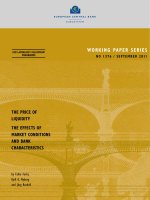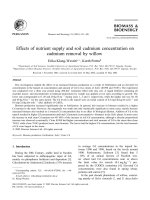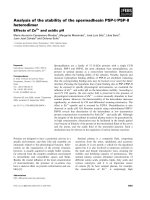Effects of stocking density and algal concentr
Bạn đang xem bản rút gọn của tài liệu. Xem và tải ngay bản đầy đủ của tài liệu tại đây (616.25 KB, 2 trang )
onlinelibrary.wiley.com
Effects of stocking density and algal
concentration on the survival, growth and
metamorphosis of Bobu Ivory shell,
Babylonia formosae habei (Neogastropoda:
Buccinidae) larvae - Zheng - 2010 Aquaculture Research
Huaiping Zheng
3-4 phút
Effects of stocking density and algal concentration on the survival, growth and
metamorphosis of Bobu Ivory shell, Babylonia formosae habei
(Neogastropoda: Buccinidae) larvae
State Key Laboratory of Marine Environmental Science, Department of Oceanography, Xiamen
University, Xiamen, China
Mariculture Research Center for Subtropical Shellfish & Algae, Shantou University, Shantou,
China
Search for more papers by this author
First published: 10 December 2010
Cited by: 2
Correspondence: C Ke, State Key Laboratory of Marine Environmental Science, Department of
Oceanography, Xiamen University, Xiamen 361005, China. E‐mail:
Get access to the full version of this article.View access options below.
Log in with Open Athens, Shibboleth, or your institutional credentials.
If you have previously obtained access with your personal account, Please log in.
Abstract
Independent and combined effects of stocking density and algal concentration on the survival,
growth and metamorphosis of the Bobu Ivory shell Babylonia formosae habei larvae were
assessed using a 5 × 5 factorial design with densities of 0.25, 0.5, 0.75, 1.00 and 1.50 larvae
mL−1 and algal concentrations of 5, 10, 15, 20 and 25 × 104 cells mL−1 in the laboratory.
Larval growth, survival and metamorphosis were significantly affected by both the independent
effects of stocking density and algal concentration and by their interaction. The highest per cent
survival (72.5%) and metamorphosis (49.5%), fastest growth (41.57 μm day−1) and shortest
time to initial metamorphosis (10 days) all occurred at the lowest stocking density and the
highest algal concentration. Both crowding and food limitation had independently negative
impacts on the survival, growth and metamorphosis of larvae, and these negative impacts were
further strengthened by the interaction of a higher stocking density and a lower algal
concentration. Moreover, the results suggest that stocking density and algal concentration
obviously played different roles in determining larval survival and growth. To maximize survival
and growth, B. formosae habei larvae should be reared at a lower stoking density of 0.25 larvae
mL−1 and fed a higher algal concentration of 25 × 104 cells mL−1 in large‐scale hatchery seed
culture.









